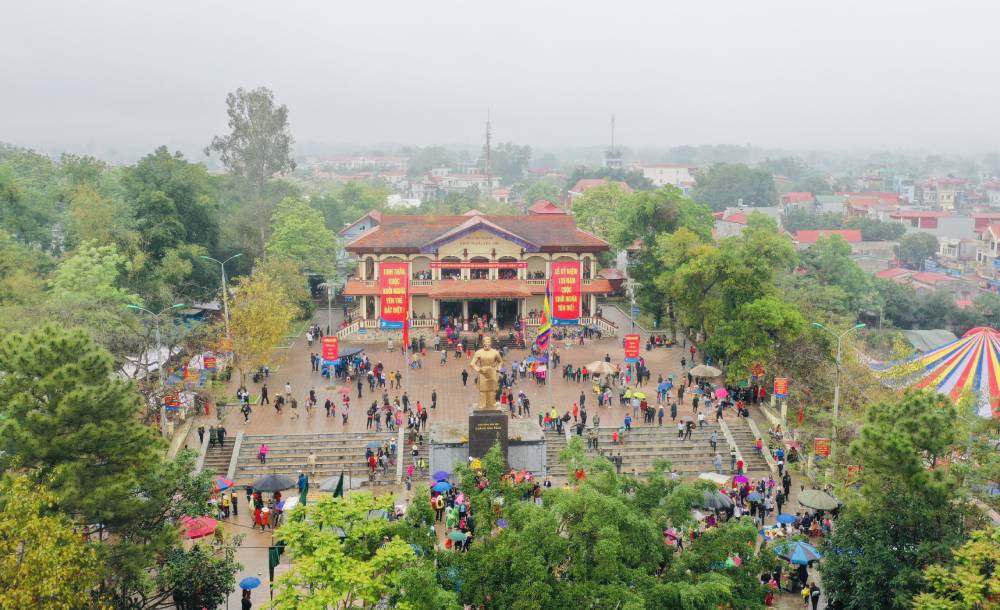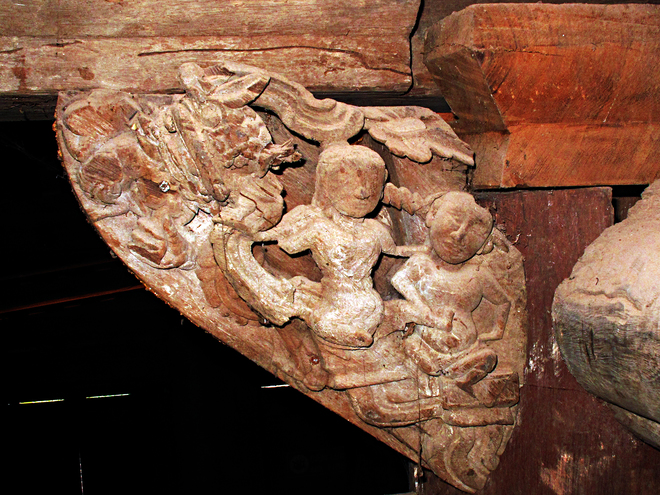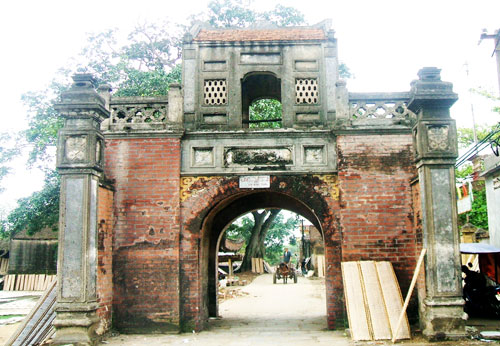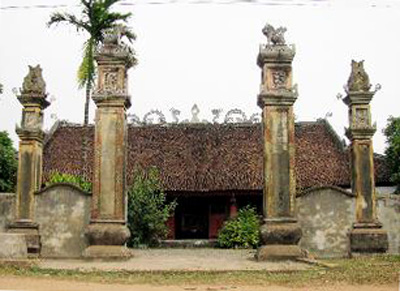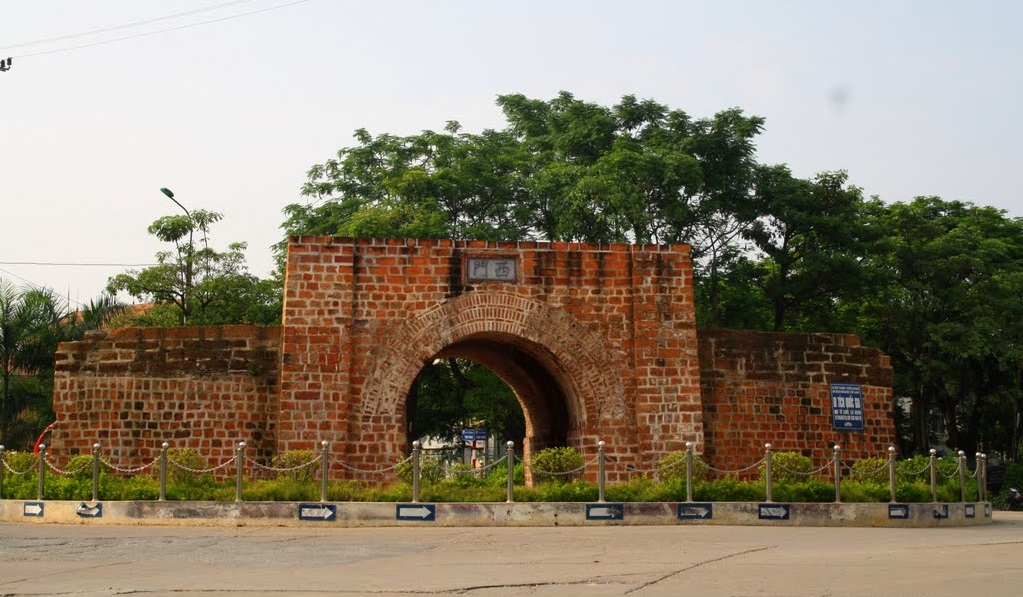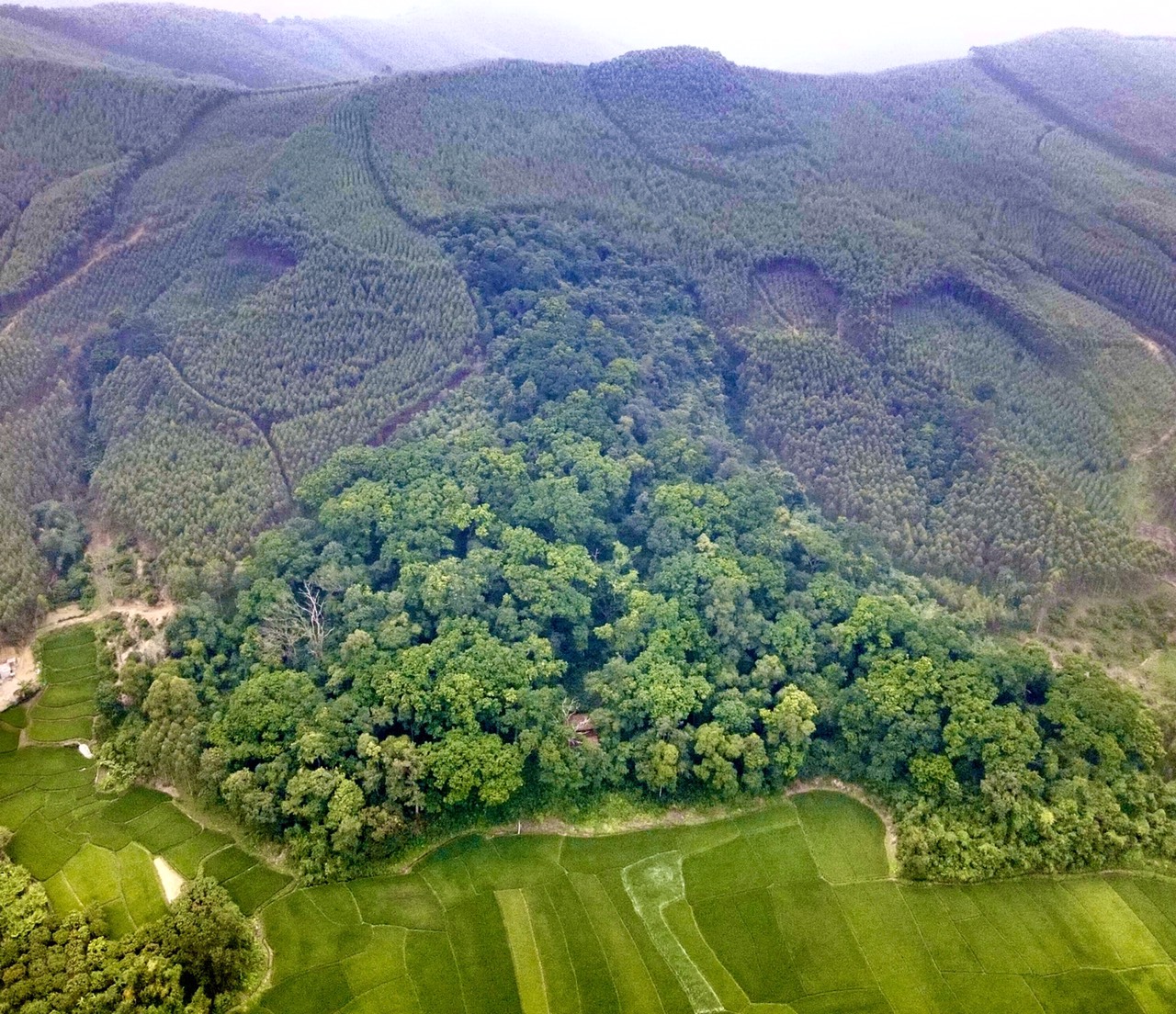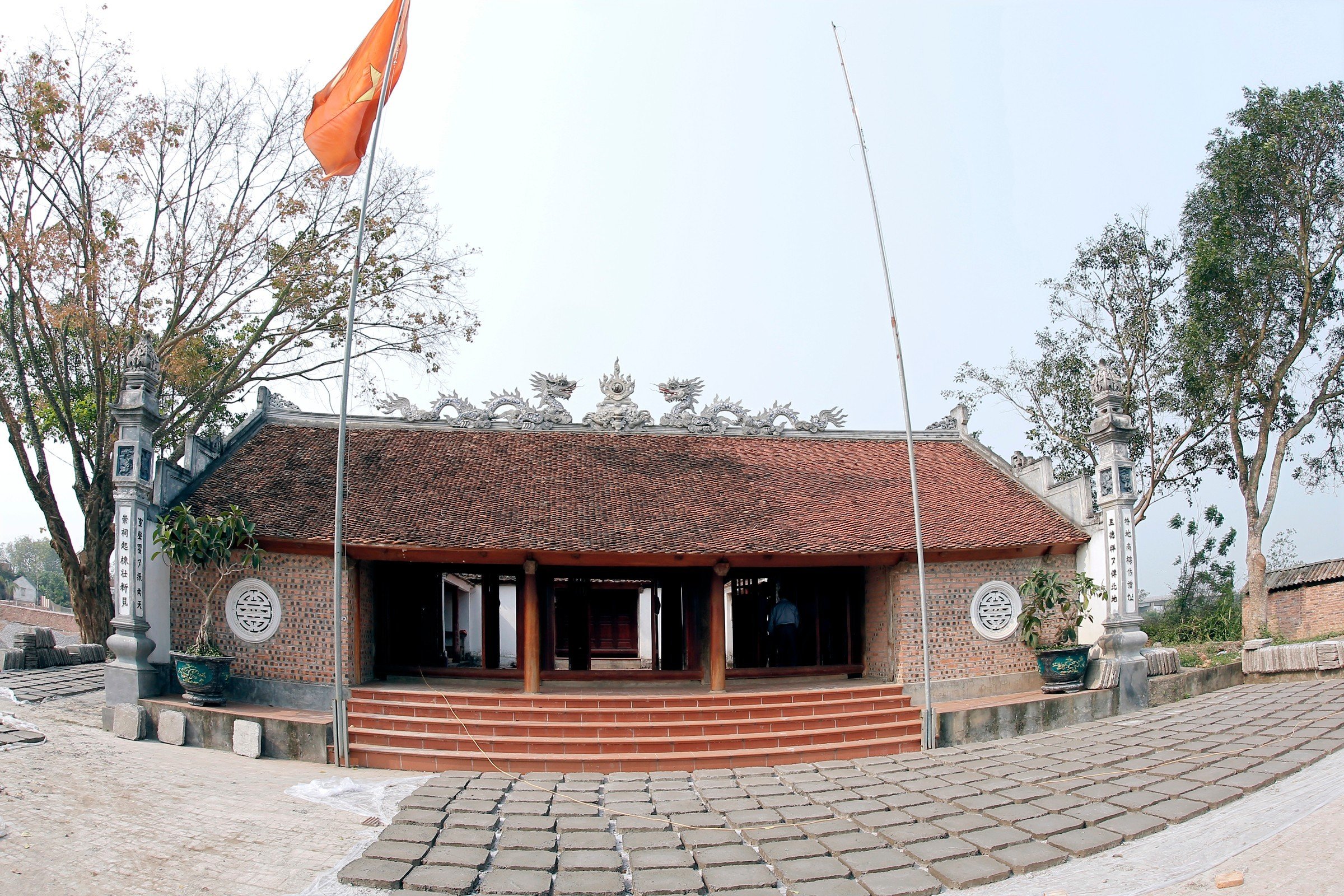Relic point Vietnam
Việt NamHoang Hoa Tham historical relic site
Hoang Hoa Tham historical relic site is located in Phon Xuong town, Yen The district, Bac Giang province. This place is associated with the resounding victory of national hero Hoang Hoa Tham - the brown-shirted leader - who together with the people of Yen The raised an uprising flag against the French colonialists nearly 30 years (1884 - 1913). This is the largest and longest peasant uprising in the history of our Vietnamese nation against foreign invaders before the Party led it. The historical and cultural relic site of the Yen The peasant uprising has created a complex of historical relics of great value. With 23 relic sites, most of them are forts, communal houses, temples, pagodas and shrines spread across 4 districts (Yen The, Tan Yen, Viet Yen and Yen Dung). The Yen The uprising relic site is convincing evidence of the brave spirit and sacrifice of the De Tham insurgent army to regain independence and freedom. To recognize and honor those special values and meanings, on May 10, 2012, the Prime Minister signed Decision No. 548/QD-TTg classifying the relic as a special national monument. Yen The district has 9 points including: Phon Xuong fort, Ho Chuoi fort, Leo pagoda, Dinh Thep communal house, Thong pagoda, Hom fort, Thien Thai cave, Cau Khoai temple and The Temple. Among them, the center of the uprising was the Hoang Hoa Tham historical relic site in Phon Xuong town, Yen The district, Bac Giang province. 1. Oath Temple In front of us is the Oath Temple. The temple was built in the late 19th century using thatch, bamboo, and leaves. In 1897, when the second peace between the French colonialists and the Yen The insurgent army took place here, De Tham repaired the temple with ironwood architecture as we see today. This architecture is still fortunately still intact. After being renovated, De Tham often used this place to hold festivals to improve the spiritual life of the people. In particular, he often used this place to recruit insurgents and recruit talented people. Before each battle, he often had the insurgents gather to drink bloody wine and swear oaths here. In May 2012, the Prime Minister signed a decision to recognize 23 relics of the Yen The uprising as special national historical relics and The Temple as one of 23 special national historical relics. there. 2. Hoang Hoa Tham Monument Located right behind the The Temple is the monument of national hero Hoang Hoa Tham. The statue was initially made of concrete, then changed to bronze in 2013, created by author Anh Vu - a member of the Bac Giang Province Literature and Arts Association in 1984. The statue is 5.07m high, surface area 31m2, average thickness 2.0cm; The statue's pedestal is 2.1x2.1m in size, 0.32m high, surface area 7m2, average thickness 2.5cm. The statue weighs over 7 tons of solid bronze, with a value of over 4 billion VND, and most of the money for making the statue came from socialization. 3. Yen The Uprising Exhibition House The next item in the relic site that any visitor cannot help but visit is the Yen The Uprising Exhibition House. The exhibition house was built in 1984 and initially had a 1-storey architecture. It was later built and remodeled and has the 2-storey architecture it has today. The first floor displays an ethnographic corner of Yen The district. The second floor displays images and artifacts of the Yen The uprising, the most typical, largest and longest spontaneous peasant uprising of our nation in the late 19th and early 20th centuries ago. when the Communist Party of Vietnam was born. 4. Phon Xuong Fort Phon Xuong Fort, also known as Don Go, Don Cu, was built in 1894, guarding the only road leading to the insurgent base. This is the main headquarters of the Yen The insurgent army, the capital of the uprising, the starting place to expand the movement to localities. De Tham built Phon Xuong Fort as both a place to live and live for De Tham's family as well as for the insurgents, and at the same time it was also a meeting and discussion place between De Tham and contemporary heroes to discuss matters. fought the enemy to save the country (like Phan Boi Chau, Phan Chu Trinh, Le Van Huan, Nguyen Dinh Kien, Ky Dong...). In particular, this is where the second peace settlement between the Yen The insurgent army and the French enemy took place. After the uprising ended, Yen The people built the temple of Ba Ba - Hoang Hoa Tham's third wife in Phon Xuong station to commemorate her great contributions in the uprising. 5. Yen The Festival Yen The Festival is held on March 15, 16, 17 every year. This is one of the biggest festivals of Bac Giang province. The festival is an opportunity for people to express their respect and remember the merits of Hoang Hoa Tham, a talented general, the supreme leader of the Yen The peasant movement and the insurgent army who fought against the French colonialists. In 2013, Yen The festival was recognized by the State as a national intangible cultural heritage. SOURCE: Bac Giang Tourism Information & Promotion Center
Bac Ninh 2501 view
Dinh Huong mausoleum
Dinh Huong Mausoleum was built in 1727 (18th century) in the mausoleum to store the body of Duke La Quy Hau. He was born in 1688 locally. In 1730, during the reign of Le Duy Phuong, he was appointed as a military servant, a military guard, and then a eunuch. During the reign of Le Y Tong, he was sent twice as envoy to the North, in 1735 and 1739. In 1740, during the reign of Le Hien Tong, he led troops to suppress rebellions in the areas of Kinh Bac, Son Nam, and Hai Duong. He died on the 9th day of the 6th month in the year of the Snake (1749), at the age of 61. In 1754, the king appointed him the title of Phuc Than Loyal Great King. In particular, the mausoleum was built by the Duke himself in his hometown when he was still alive. Dinh Huong Mausoleum is located on a circular hill, about one hectare wide, surrounded by laterite walls (recently renovated). The architectural layout of the mausoleum consists of three main parts: the burial part in the middle, the worship part on the left, and the stele part on the right. The stone mausoleum is about 100 square meters built of square laterite. In front of the tomb are two mandarins leading horses standing facing each other. The pair of statues of mandarins leading horses are considered masterpieces of stone carving art. The military officer wearing a sword and leading a horse on the right side has a big face and wide jaw. The military officer carrying a sword and leading a horse on the left side has a long beard and small face. The entire statue's shape is elaborately carved to exude an extraordinary, dignified appearance. Coming to Dinh Huong Mausoleum, visitors will admire the worship area, which is also built square like the burial area, with walls made of laterite, steps built in front, a stone collapse on top, an altar throne, and on both sides there are statues of maids. The casket and the couple lie prostrate. Below the altar is an incense burner, a stone table, and a pair of goats sitting with their heads facing each other across the Shinto path. In the distance, a pair of elephants knelt down and prostrated themselves. On the right side of the grave is a stele house with 4 arched rolling doors, inside is a stone stele recording the merits of the person being worshiped. The inscription says that the stele was created in 1729. Overall, the materials used to create the artistic architectural work of Dinh Huong mausoleum are mainly green stone, finely chiseled and trimmed with fire cloud motifs, high-embossed spiral clusters, and interlocking geometric patterns. hooked together and posted oppositely. What is most unique about this architectural work is the art of carving round statues in a realistic style with a naturalistic tendency. Statues of people and animals at the mausoleum are made of green stone, carved very vividly. The statue is large in size, fat, sturdy, and meticulously trimmed. It can be said that this is a massive architectural work, elaborately carved in stone with skillful craftsmanship. The mausoleum complex is a typical first-class stone art sculpture in Bac Giang province. The antiques in the mausoleum are preserved relatively intact Tourists visiting Dinh Huong Mausoleum will be fascinated by the stone sculpture art of ancient artisans. The highlight and unique feature of Dinh Huong mausoleum are the massive statues, much larger than those in other mausoleums, delicately carved. According to statistics, in Bac Giang, 46 ancient stone structures have been discovered and recognized, mainly stone mausoleums. The stone mausoleum system is proof of the art of tomb sculpture that has developed to its peak and holds an important position in the architecture and ancient stone sculpture of Vietnamese mausoleums. These are truly the quintessence of ancient sculpture, with sophistication expressed in every line on the statues. Artifacts and stone statues also contribute to increasing the historical value and cultural and artistic value of ancient mausoleums. Dinh Huong Mausoleum is a place to honor the nation's architectural tradition of stone sculpture, clearly shown in the art of sculpting statues of people or sacred beasts and worshiping objects, as well as rich architectural decorations and life-style patterns. The cave is truly typical of ancient Vietnamese stone sculpture art. With values of cultural history and typical architectural art, Dinh Huong mausoleum has been attracting tourists to visit. SOURCE OF BAC GIANG TOURISM
Bac Ninh 2027 view
Phu Lao Communal House
Phu Lao Communal House in Phu Lao village, Dao My commune, Lang Giang district, Bac Giang province. Despite many years of war, devastation from sun and rain, and deterioration due to many renovations, Phu Lao communal house still retains the basic features of an ancient Vietnamese communal house, especially the about art and architecture. Phu Lao Communal House was built in 1688, during the reign of King Le Chinh Hoa the 15th. Phu Lao Communal House was built on a campus of more than 1,500 square meters at the beginning of the village, looking to the Southeast to worship Duc Cao Son - Quy Minh who are the kings. Famous generals of the Hung King period were instrumental in suppressing the enemy and defending the country. These are famous generals whose temples were built in many places in the Northeast region to honor those who contributed to the village and the country. They were ordained as superior gods by many dynasties and were classified as Gods of Goodness, eliminating evil, eliminating evil and protecting good people. At the same time, the communal house also worships General Cong Dao and Lady Quy Thi, local people who passed the exam to become mandarins, and donated money to build a communal house to merit the village. Phu Lao communal house is located on a high, open, beautiful strip of land at the beginning of the village, the back of the communal house is built outward, the communal house's face faces the village, hidden under the cool green banyan shade, reflecting on the clear water wharf. In front of the communal house's door, there is a large, semi-oval pond and the communal house's yard is large and flat. The newly built altar house consists of three small rooms. In the back yard of the altar there is a four-sided stele, built in the 15th year of Chinh Hoa (1694), composed by Dr. Hoang, talking about his contribution to building the communal house. Ms. Dao Thi Hien. The communal house has four high, wide roofs, the roof is covered with bai-shaped tiles. The great hall consists of seven compartments, 23m long, 12m wide, with 8 trusses, 6 rows of columns, 48 columns. The trusses are structured in a way that overlaps the beams and gongs, combined with stripes at the four corners. The four middle columns have four panels running nearly the entire room, creating four large decorative panels. The four sides of the pavilion still have traces of paneling and are surrounded by a table door; All rooms have floors. Except for columns, rafters and diaphragms, other wooden architectural structures such as wooden poles, corbels, planks, stripes, pillars... are carved with many shapes reflecting aspects of village life. With its unique architectural and wood carving art values, since 1982 Phu Lao communal house has been recognized by the State as a nationally ranked historical relic, after being restored twice to prevent deterioration. , most recently in 2011, up to now, the state, party committees, authorities, social organizations, especially Buddhists everywhere have contributed to building relics that are getting better and better, in order to preserve the relics. the unique cultural values of our ancestors for our descendants for generations to come. SOURCE World Heritage e-magazine
Bac Ninh 1658 view
Listening to battles - a mark of the Le dynasty
Nghe Battle relic is located on a hillock, about 1.2 km southeast of Kep town center (Lang Giang district). Distance from city center. Bac Giang is about 20 km to the Northeast. With a total area of 1,143.2 m2, Nghe Battle is a historical and cultural relic of the people and locality of Kep Village, Can Dinh commune, Can Dinh canton, Bao Loc district, Lang Giang district, Kinh Bac region. Now belongs to Kep 11 and Kep 12 villages, Huong Son commune, Lang Giang district. Currently, Nghe Trien has an architectural plan in the style of Dinh with 03 pre-worship spaces connecting 02 back palace spaces. Mr. Nguyen Quang Tho, 84 years old, in Kep 11 village, Huong Son commune - Head of the Subcommittee for the Management of Nghe Trien historical and cultural relics, said that according to ancient legend, Nghe Truong worships the two generals Trung. When the Can Tram battle was fierce, many insurgents and generals died in this area. People set up a altar to worship the souls of the insurgents and generals, from which it was called "The Battle". Currently, the remaining relics and artifacts are preserved in relics such as: the holy palanquin of the Le Dynasty (18th century); Phu Lang ceramic incense bowl (19th century); 02 ancient statues of the Nguyen Dynasty (20th century). The altar thrones, statues, incense bowls, bronze bells, flower vases and other worship objects prove that Nghe Battle was built in the 18th century. Located in the relic complex of Can Tram citadel (Kep town, Lang Giang district) associated with our people's resistance war against the Ming army in the early 15th century. Nghe Battle is an ancient cultural and religious historical work. , a long time ago (18th century) with important historical and cultural significance for the people and localities in the region. During the resistance war against the French colonialists in the period 1946-1947, the French enemy bombarded the area of Kep village, Nghe Truong was also destroyed and damaged, local people many times contributed money, contributed to repairing and renovating. The project has been degraded after many centuries of use. People and local authorities at all levels have repeatedly contributed effort and money to invest in renovation and repair. The main milestones were in 1991 and 2006, investing in repairing a number of items and rebuilding 02 halls of the harem court. In 2019, building 03 new, beautiful and spacious halls of the pre-worship court. In 2009, Nghe Battle was ranked and recognized as a provincial-level historical and cultural relic by the People's Committee of Bac Giang province (Decision No. 1587/QD-UBND dated September 17, 2009). Contributing to enhancing the meaning and value of history and traditional culture of the people in the region and serving tourists who come to study and visit increasingly developed tourism. SOURCE Bac Giang Tourism Information & Promotion Center
Bac Ninh 2005 view
ATK2 Hoang Van area
Hoang Van Safety Area is located in Hiep Hoa district, Bac Giang province, 35km west of Bac Giang city. This is one of the loyal revolutionary bases, where many Party leaders worked before the August 1945 revolution, and where the Central Party Central Committee's Tonkin revolutionary military conference took place in April. /1945 chaired by General Secretary Truong Chinh to prepare for the revolutionary armed uprising to seize power in August 1945. Here you will be introduced to an overview of the Party's revolutionary base in the pre-uprising period, and visit some historical revolutionary relics of ATK: the place where the Party's revolutionary political training class was opened in the pre-uprising period. , where the revolutionary military conference of the Party Central Committee took place, visited Van Xuyen communal house in the "Red hamlet", a place associated with many revolutionary events in the locality, visited Y Son temple and mountain in Hoa Son commune, sightseeing and listen to an introduction to the history, architecture, precious relics of the temple, burn incense for luck, fortune, and wealth at the Temple. SOURCE: BAC GIANG DEPARTMENT OF CULTURE, SPORTS AND TOURISM CENTER FOR INFORMATION - TOURISM PROMOTION
Bac Ninh 1857 view
Document of Tho Ha village
The Tho Ha village document was built in the 17th century (according to the preserved stele, it was built in the 5th year of Vinh Thinh, 1680) to worship Confucius, Tu Phoi, 72 sages..., this place is considered is the cradle of Tho Ha education. This is also a place that attracts a large number of tourists, especially during the exam season, when scholars come here to burn incense and worship with sincere hearts. In particular, Tho Ha village has no fields, only residential land with an area of 20 hectares and a population of nearly 3,800 people. With such natural and social conditions, right from the village's founding, the people here chose a suitable profession to exploit many advantages. The chosen profession is pottery. It is the pottery profession that has created a bustling and famous Tho Ha. The village has been the most important ceramic center of the Northern Delta for several hundred years, next to Phu Lang and Bat Trang. Ancient Tho Ha pottery did not use glaze, that magical flexible clay was fired until the glaze spontaneously melted, clinging to the surface of the pottery in a shiny brown color, smooth as velvet, cool. The village only makes household ceramics, jars, small clay pots, and rice bowls that were famous at one time. The surface of the ceramic is dark purple, hard, and makes a sound like hitting cold steel. The remaining pieces of ancient pottery on the walls are still intact, and that's why the ceramic soul seems to linger forever. Along with pottery, rice paper making, noodle making, rice paper making, wine making, confectionery making, and services have also developed in Tho Ha, the village is often called a "multi-craft village". These occupations have created a new look for the village, through which we can see the boundless diligence and creativity of the people here. As a rich traditional craft village for hundreds of years, this place also has the interference of many unique cultural features of regions throughout the country. Among them, the most special are festivals with many traditional cultural activities such as: singing traditional opera, singing Quan ho, playing Chinese chess, cockfighting, table tennis... Ancient beauty with ancient architectural areas, ancient villages, unique culture along with traditional crafts imbued with the soul of the countryside, Tho Ha has been a familiar and attractive address for domestic and foreign tourists to visit. mandarin SOURCE: BAC GIANG PROVINCE ELECTRONIC INFORMATION PORTAL
Bac Ninh 1612 view
Dinh Lo Hanh
Dinh Lo Hanh Lo Hanh communal house is the common communal house of 5 villages: Cham, Chung, Khoat, Chua and Hanh, so it is also called Ca communal house. The communal house was built in the 11th year of Sung Khang (1576), worshiping Cao Son Dai Vuong and Phuong Dung Tien Chua - two gods who had meritorious services to the country and people during the time of King Hung. Lo Hanh Communal House has unique cultural value with sophisticated and unique carvings of dragons, phoenixes, deer, flowers, and scenes of human activities. Currently, the communal house still preserves many precious relics such as: two lacquer paintings of "The Eight Immortals" in the middle space in front of the harem door, a pair of 17th-century lacquered and gilded wooden chairs, a statue of Phuong Dung Tien Chua and the Cao Cao tablet. Son Dai Vuong..., especially the carving of a fairy strumming a bottom instrument - a testament to the birth and early development of Ca Tru in Vietnam. Initially, Lo Hanh communal house only had a large communal house shaped like the word "first". Through many renovations in 1694, 1850 and 1910, the communal house was built with a harem and two rows of left and right vu. The floor of the great communal house is 23.5m long, 12.3m wide, the height from the roof beam down is 6.6m, from the roof edge down is 2.1m; includes 5 compartments, 2 wings with 8 rafters, 4 main rows of columns and 2 rows of porch columns supporting under traps. The trusses have different structures, the middle rafters are all made in the style of "stacking beams and gongs", the side rafters are made in the "one who spreads gongs" style. On December 24, 1982, Lo Hanh communal house was ranked as a historical relic by the Ministry of Culture (now the Ministry of Culture, Sports and Tourism). SOURCE: DISCOVER VIETNAM TOURISM IN BAC GIANG PROVINCE
Bac Ninh 1993 view
BECOME A THEATER OF THEATER
The citadel of the Mac dynasty was built with soil from the late 16th century, running from South to North from Bao Dai mountain, passing Mount Ai (Dong Phu), along the north side of the mountain, running into Trai Mit area (Tien Nha) and then feeding into Luc Nam river, across the bank. On the East side, run into the land of Vuon village, Ho Nuoc village, into the Han Lam temple area (Nghia Phuong), then stop at the foot of Mang mountain in the Huyen Dinh - Yen Tu range. The Mac Dynasty Citadel runs across the Luc Nam River valley for about 18km, and is a relic of ancient military talent. During the Le Trung Hung period, many ancient architectural works such as communal houses and pagodas were left in Bac Giang, such as Tho Ha communal house, Huong Cau communal house, Dong Lam communal house, San communal house, Than communal house, Dan Hoi communal house, Ha My communal house, and Ha My communal house. Bao Son, Gai communal house, Trung Dong communal house..., Te pagoda, Trung An, Non village, Kham Lang, Trang pagoda (Dong Phu), Vuon village (Cuong Son), Hui village (Dan Hoi)..., Hiep ancient stone mausoleum system Hoa, Viet Yen, Tan Yen. During the Tay Son period in Luc Nam, there was also the Ria communal house (Dong Phu) with the date of creation: Hoang Trieu Bao Hung's second year of creation (i.e. Bao Hung's reign, year 2 - 1802). Modern times clearly marked relics in the relic system related to the Yen The peasant uprising. During the anti-French and anti-American period, Bac Giang had the Mai Suu Military Training Center, the location where American planes were shot down in Duong Huu and Nghia Phuong communes. SOURCE: BAC GIANG DEPARTMENT OF CULTURE, SPORTS AND TOURISM CENTER FOR INFORMATION - TOURISM PROMOTION
Bac Ninh 1656 view
Forbidden Forest Communal House
Forbidden Rung Cam Communal House in Phe village, Van Son commune is a place to worship the hero of the 11th century Song Dynasty - the concubine Than Canh Phuc who married Princess Thien Thanh, son of King Ly Thanh Tong, and is a place for cultural and religious activities of the people. Tay ethnic group in Van Son region. Forbidden Forest Communal House is located on a land with a beautiful terrain, in the middle of a field, with ancient trees providing shade, in front of the Communal House is the Champa Nam stream that leads the water flowing around it; The current forbidden forest communal house has a 3-compartment vestibule, 1-compartment harem looking to the East. In the temple, there are still 4 stone legs and a yin-yang stone of great value in scientific research and discovery. understand the history of local monuments. Every year, people hold a festival on the 11th day of the third lunar month with sacrifices and incense offerings to commemorate the merits of the Village God who has contributed to the people and the country. With historical and cultural values, on December 7, 2021, the People's Committee of Bac Giang province issued Decision No. 2499/QD - People's Committee ranking Forbidden Forest Communal House as a provincial-level historical and cultural relic in 2021. At the ceremony, authorized by the Chairman of the Provincial People's Committee, leaders of the Bac Giang Provincial Museum and the District Department of Culture and Sports awarded the Provincial-level relic ranking certificate of the Forbidden Forest Communal House to the Party Committee, authorities and people of Van commune. Paint. SOURCE: SON DONG DISTRICT ELECTRONIC INFORMATION PORTAL
Bac Ninh 1729 view
Relics of communal house and Lan Tranh pagoda
Lan Tranh communal house and pagoda formerly belonged to Lan Tranh commune, Tuy Loc Son district, Yen The district, Bac Giang province. Nowadays, Lan Tranh communal house and pagoda belong to 3 villages (Lan Tranh 1, Lan Tranh 2, Lan Tranh 3), Lien Chung commune, Tan Yen district, Bac Giang province. Before the August Revolution of 1945, Lan Tranh village was also Lan Tranh commune of Tuy Loc Son district, Yen The district, Bac Giang province including 3 villages: Middle village, Lower village, Upper village. After the August Revolution of 1945, the general level was eliminated. In 1957, Tan Yen district was established, this place belongs to Hoa Binh commune. In 1973, the name was changed to Lien Chung commune. Based on the current status of the relic, documentary sources of artifacts and worship objects in the relic show that Lan Tranh communal house was built during the reign of Le Trung Hung (around the 18th century). During the resistance war against the French, in 1946, people donated some bronze and wooden worship objects to the revolution, so the communal house was no longer intact as before. Up to now, the people of Lan Tranh village have restored the communal house using old materials and artifacts. Communal houses and pagodas are arranged in the style of "Before the gods, then after the Buddha" (the communal house first, the pagoda later). The relic has the ancient beauty of the architectural works of Le Trung Hung's reign and has historical and cultural value. During the years of resistance against the French colonialists, Lan Tranh communal house and pagoda were also a place to develop self-defense forces, protect revolutionary cadres, and store food to serve the resistance. During the resistance war against the Americans, communal houses and pagodas were where Ke prison camp was evacuated. Based on the current status of the relic, on documentary sources and artifacts such as horizontal panels, couplets, worshiping texts, orations, worship objects... contained in the relic and the respectful worship of the people of Lan Tranh village for You know, Lan Tranh communal house worships Cao Son and Quy Minh gods. The communal house is located on a turtle-shaped mound at the edge of the village, in a quiet space, overlooking the south and east. In front of the communal house is a large field and on the left is the winding Thuong River. Surrounded on 3 sides are densely populated residential areas, creating a landscape that is both quiet but warm with a village and countryside feel. Going through the village road, we turned into the large land and entered the communal house yard. The communal house's yard is spacious and square. To the right of the communal house is a large soccer field, formerly the communal pond. Lan Tranh Communal House has a layout in the shape of the letter Nhi, including: the front hall and the back palace. Go through the courtyard to enter the altar hall. This building has a straight roof, with a picture of two dragons flanking a moon on top. The two gables are built in the style of a stepped three-mountain throne. In front of the front gable are two bronze pillars with two parallel sentences written on them. The front altar has 5 compartments, 2 shelves, and paneled doors. The size of each compartment is 2.5m wide, the two ends are 0.5m wide. The height from the ground to the roof of the house is 4.25m. This building has 5 compartments, 6 floors and 5 rows of pillars. The main column is 3.55m high, the military column is 2.7m high, and the porch column is 2.15m high. The architectural structure of the altar building follows the traditional style of lines and gong stands. The harem building has a 2-vaulted space, in the middle there are two gables guarding the wall and 3 rows of pillars made of 6 pillars. Each compartment has a width of 2.4m, the height from the ground to the roof of the harem is 3.50m. The distance between two main columns is 1.5m. The sculptural art of Lan Tranh communal house is concentrated in architectural structures. That is the system of column bases, architectural structures, walls, cocks, ends, traps... On the ends of each column are engraved beautiful curling symbols, expressing the wishes of the Vietnamese people. Nam wants to pray for good weather and a prosperous life. In particular, the communal house has a system of large, strong and sturdy pillars, and the joints and paths are all fitted together, creating a strong, elegant, and poised appearance. That confirms the creative talent of ancient artisans, to have a large, beautiful and majestic architectural work for us today. SOURCE: ELECTRONIC INFORMATION PORTAL OF CANH THUY COMMUNE - YEN DUNG DISTRICT - BAC GIANG PROVINCE
Bac Ninh 1763 view
